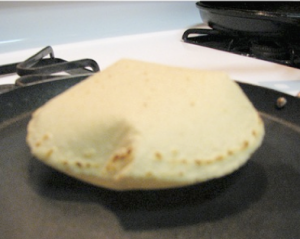Award Winning Author
Face Reading with Before & After Photos
Corn Tortillas Recipe
As virtually all nonorganic corn products are GMO, making your own tortillas with organic masa is a prudent—and tasty—choice. Thankfully, quality organic masa is now available (organic products are free of genetically modified organisms). Of the various types of gluten-free bread, here’s why homemade tortillas are unparalleled. 
When making tortillas, you turn them twice on the griddle and, with the second turning, interior steam builds up and momentarily puffs the bread up to three times its size. This interior steaming enhances both its texture and its flavor. When factory made or made in an electric tortilla cooker, the breads can’t puff and therefore don’t get the bonus steam-cooking step; while technically they are flatbreads made of masa, they’re not the real deal.
A hand made tortilla with its earthy masa flavor and chewy, tender and pliable texture, is made from slaked or lime-treated corn and is nutritionally superior to corn flour and more mineral dense. It’s also easier to digest and boasts a deeper flavor.
Making tortillas from scratch also enables you to use organic masa and to choose between white, yellow or blue masa. Blue masa tortillas are a little more fragile and more subtly flavored than white or yellow, and yellow masa has the most “corny” flavor. Or go for it, treat yourself to tortillas of all three colors and flavors!
Makes 12
2 cups white, blue or yellow corn masa
About 1 1/4 cups hot water
Place the masa in a large bowl. Stir in water until well combined and the dough forms a ball that is moist and pliable (as corn is gluten-free, you can’t overknead it). If it sticks to your hands, add a little more masa; if it is dry and crumbly, add a little more water. Turn the dough out onto a clean surface and knead for about 5 minutes, until it is smooth and silky and a pinch of dough will easily press flat when pushed between your fingertips. Cover the dough with plastic wrap and let it rest for at least 5 minutes but no more than 30 minutes.
Divide the dough into 12 equal-size balls and roll each ball between your palms until it is smooth. Cover the balls with plastic wrap to keep them from drying out.
Preheat an ungreased cast-iron skillet or griddle over medium-high heat; do not cook on a nonstick surface.
Shaping Tortillas by Hand: Press one ball into a disc shape. Gently roll the disk between 2 sheets of plastic wrap or parchment paper into a circular shape of uniform thickness. Or use the bottom of a plate or pie plate to press it flat. Toss the tortilla back and forth between your hands a few times to aerate it. Cover it with plastic wrap to keep it moist while you shape the remaining dough.
Using a Tortilla Press: Press one ball into a disc shape. Place the disk into a tortilla press (to prevent the dough from sticking, cover the press with parchment paper or with sheets of plastic). Press down. Open the press; turn the tortilla 180 degrees. Lower the top and again press down to create a round disc of uniform thickness. Remove the tortilla from the press and toss it back and forth between your hands a few times to aerate it.
One at a time, place tortillas on the preheated skillet or griddle and cook for 30 seconds. Turn and cook for an additional 1 minute, or until lightly browned in spots. Typically the tortilla will momentarily puff up and then deflate; if it does not inflate, using a clean cotton cloth or metal spatula, briefly press it down and release it. This usually enables the tortilla to puff up; if it still doesn’t slightly inflate, turn and bake for another 30 seconds. Remove the tortilla from the griddle and keep warm, tightly wrapped in a cloth or kitchen towel while you bake the remaining tortillas.
Allow the wrapped tortillas to rest for about 15 minutes to finish cooking and become soft and pliable. Tortillas are best eaten soon after they are made, but they will keep, tightly wrapped and refrigerated, for up to 5 days. Photo credit: Mexico in My Kitchen.


O how I would love to have these, but being allergic to corn makes it impossible. Any thoughts as to how I could reach a similar result with anything other than corn? I am also allergic to wheat, barley and rye.
I know of no substitute for corn masa.